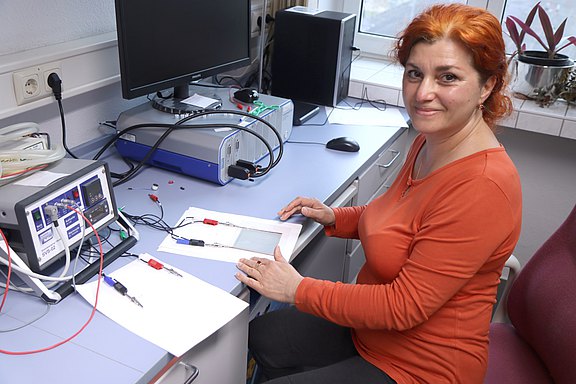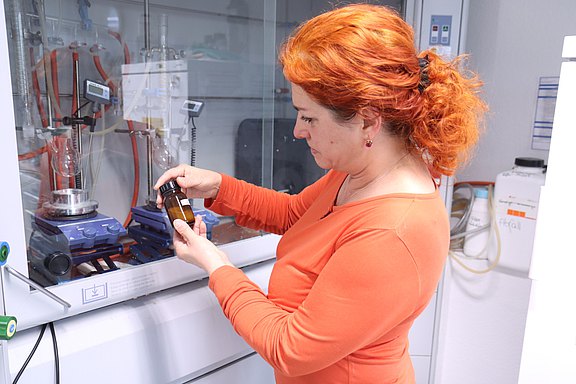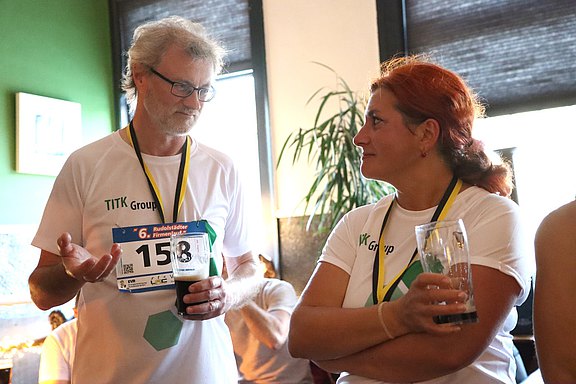What started as an exchange program has resulted in a meanwhile 21-year scientific career at TITK. The chemist Dr. Gulnara Konkin has been enriching the department Functional Polymer Systems for two decades. Electrochromic systems like artificial muscle cells or textile applications – Dr. Konkin’s research activities are diverse and are designed to make life easier.
Always stay calm and strong – this is the life motto of the 55-year-old scientist. It is particularly evident in her manner of doing research. Challenges or errors do not unsettle her but give her indications of new ways and alternative approaches. “After each project I come up directly with ideas of how to continue to treat the topic. What can be enhanced, how can we further develop the topic?”
The best example is one of her latest projects – “elmutex: electrochromic multifunctional textiles”. Together with her team Konkin developed a textile display changing its color by using a sensor. With such displays messages like warning or emergency signals can be visualized. The approach for this research was to facilitate the communication in critical situations. Usually, children or elderly people are often not able to recognize written warnings. The language of colors, however, is a particularly simple method of communication: red signifies danger, whereas blue or green mean safety. Thus, for example, diseases or dangerous situations could be recognized earlier. A person measuring the blood pressure regularly would not need to decipher small numbers but could rely on the color. Is the blood pressure too high, the sensor sends a signal to the control unit which outputs the color red.
Moisture detection warning system for the care sector
While presenting the research results the idea for the next project was born: Can these displays also be integrated in an identification system for moisture? As, especially in the care sector, it is sometimes difficult to recognize whether incontinence pads, for instance, have to be changed. To find out, duvets have to be lifted and patients are often unnecessarily stressed. A so-called moisture recognition warning system in bed pads could analyze that and, therefore, reduce the workload of the working staff and the stressful situations of the affected persons. Research shall be continued in this sector in cooperation with two nursing facilities.
Konkin laid the foundations for her work in electrochemistry during her long time at the university in Russian Kasan – her hometown. Already in the 7th grade it was clear that chemistry was her future. She liked the basic work at university so much that she stayed there and wrote her PhD thesis about inorganic coordination compounds in 1995. For ten years, she taught and researched at the university Kasan, until a new opportunity opened up.
Professor Hans-Klaus Roth, at that time leader of the department Functional Polymer Systems at the TITK, had various contacts to Russia due to his own professional career. At the turn of the millennium he invited Gulnara Konkin to come to Rudolstadt as a guest researcher for an exchange year. One year became two years and two years now have become 21. It was not easy at the beginning, but here, too, she stayed true to her motto – she learned the German language step by step with calm and strength, discovered the new research area of electrochemistry and familiarized with foreign structures.
Switching from basic research to industry-oriented research has never been a problem for her. On the contrary, the wide variety makes it particularly interesting. For scientists working at an industry-oriented institute have to be up to date in a lot of areas at the same time and keep an eye on practical and market relevance at every project from the beginning. This allows for big freedoms and a lot of variation. “Each day is different. We are not a production site where the same is produced every day. Research is always multifaceted. I have the possibility to choose and realize topics which interest me”, she says enthusiastically.
Glove exoskeleton to help with limited muscle strength
She had also chosen to research on the topic “textile muscles”. ITP GmbH, a development company for technical textiles, enquired whether there was interest in a joint project. The aim is to investigate and develop a lightweight interactive glove exoskeleton. Gulnara Konkin was immediately enthusiastic about it and confirmed. She has been involved in this project for one and a half year and wants to make the world easier for people with limited muscle strength. Thereby, innovative textile actuators support the fingers’ strength. The approach is of physical nature: Silicon electrodes are embedded with an electrolyte which leads to a volume increase when voltage is applied. The volume increase, which requires just little electrical energy, is transformed into a curvature. Therefore, by the help of the glove the fingers bend and muscles still existing rudimentarily are supported. People who do not or just very restrictedly use their hands are then able to grip a cup, for instance, and to improve their daily life.
Power for doing research and inspiration for new ideas, this is what Gulnara Konkin gains while working in the garden. She grows regional herbs in her herb patch and preserves jam from the fruit of her trees. She would like to stay healthy and fit. She has repeatedly demonstrated that she still is by participating at the company run in the team of the TITK group. “It would be nice if things could remain as they currently are”, Konkin sums up.
Returning to Russia is not on her agenda anymore. She has been officially a German citizen for eleven years. Her two suns were born here and want to stay in Germany as well. “The elder one is very much interested in technics and the younger one is becoming a physicist”, she is sure. She is very much grateful particularly to Professor Roth who paved the way to Rudolstadt 21 years ago. “He gave my life an important new direction. Without him and the current department leader Professor Heinemann I would not be where I am now.”


